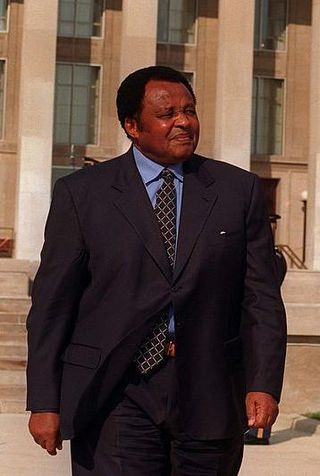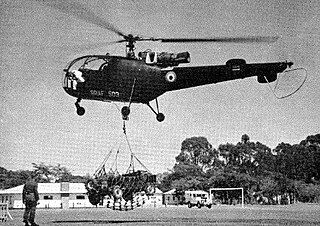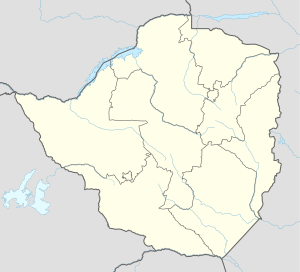
uMkhonto we Sizwe was the paramilitary wing of the African National Congress (ANC), and was founded by Nelson Mandela in the wake of the Sharpeville massacre. Its mission was to fight against the South African government.

The Rhodesian African Rifles (RAR) was a regiment of the Rhodesian Army. The ranks of the RAR were recruited from the black African population, although officers were generally from the white population. The regiment was formed in May 1940 in the British colony of Southern Rhodesia.

Zimbabwe People's Revolutionary Army (ZIPRA) was the military wing of the Zimbabwe African People's Union (ZAPU), a Marxist–Leninist political party in Rhodesia. It participated in the Rhodesian Bush War against white minority rule of Rhodesia. ZIPRA was formed during the 1960s by the nationalist leader Jason Moyo, the deputy of Joshua Nkomo.

The 1st Battalion, Rhodesian Light Infantry (1RLI), commonly The Rhodesian Light Infantry (RLI), was a regiment formed in 1961 at Brady Barracks as a light infantry unit within the army of the Federation of Rhodesia and Nyasaland. Barely a year after its creation, it was relocated to Cranborne Barracks (Salisbury) where its headquarters remained for the rest of its existence. The Regiment became part of the Southern Rhodesian Army when the Federation dissolved at the start of 1964 and, later that year, reformed into a commando battalion.

Johannes "Joe" Modise was a South African political figure. He helped to found uMkhonto we Sizwe, the military wing of the African National Congress, and was its longest serving Commander in Chief, deputised at different points in time by Joe Slovo and Chris Hani. Modise headed MK for a 25-year period, from 1965 to 1990. He served as South Africa's first black Minister of Defence from 1994 to 1999 and led the formation of the post-independence defence force.

The military history of Zimbabwe chronicles a vast time period and complex events from the dawn of history until the present time. It covers invasions of native peoples of Africa, encroachment by Europeans, and civil conflict.

The 1st Battalion, The Rhodesian Light Infantry, commonly the Rhodesian Light Infantry, was originally formed in 1961 as a regiment of the army of the Federation of Rhodesia and Nyasaland. Raised as a light infantry unit at Brady Barracks, Bulawayo in Southern Rhodesia, the Regiment served in the Rhodesian Bush War as part of the Rhodesian Security Forces between 1964 and 1979, from 1965 under the unrecognised governments of Rhodesia and latterly, during the second half of 1979, Zimbabwe Rhodesia. The RLI remained active during an interim period under British control and then, from April 1980, within the armed forces of Zimbabwe, before disbanding on 31 October 1980.

The 1st Battalion, The Rhodesian Light Infantry, commonly the Rhodesian Light Infantry, served in the Rhodesian Bush War as part of the Rhodesian Security Forces between 1964 and 1979, under the unrecognised government of Rhodesia following its 1965 Unilateral Declaration of Independence from Britain. During the second half of 1979 it fought for Zimbabwe Rhodesia, a black majority-ruled version of the same state which also failed to win international recognition. After an interim period under British control from December 1979 to April 1980, the RLI briefly remained active within the armed forces of Zimbabwe, but did not see action under this government. It disbanded on 31 October 1980.
The 1st Battalion, The Rhodesian Light Infantry, commonly the Rhodesian Light Infantry, served in the Rhodesian Bush War as part of the Rhodesian Security Forces between 1964 and 1979, under the unrecognised government of Rhodesia after its Unilateral Declaration of Independence from Britain on 11 November 1965. Latterly, during the second half of 1979, it fought for Zimbabwe Rhodesia, a reorganised version of Rhodesia under a black majority government which still went unrecognised. After an interim period under British control from December 1979 to April 1980, the RLI briefly remained active within the armed forces of the internationally recognised Republic of Zimbabwe, but did not see action under this government. It laid up its colours on 17 October 1980 and disbanded two weeks later.

7 Independent Company was a short-lived company of francophone volunteers in the Rhodesian Army during the Rhodesian Bush War. Numbering about 200 men at its peak, it was unique in the history of the Rhodesian Army as an exclusively expatriate unit. It existed between November 1977 and May 1978 as a company in the 1st Battalion, the Rhodesia Regiment, and served two counter-insurgency tours on Operation Hurricane in north-eastern Rhodesia.
The 1981 Entumbane uprising, also known as the Battle of Bulawayo or Entumbane II, occurred between 8 and 12 February 1981 in and around Bulawayo, Zimbabwe amid political tensions in the newly independent state. Zimbabwe People's Revolutionary Army (ZIPRA) guerrillas, mainly in the city's western suburb of Entumbane, rebelled, creating a situation that threatened to develop into a fresh civil war, barely a year after the end of the Bush War. The Rhodesian African Rifles (RAR) and other white-commanded elements of the former Rhodesian Security Forces, fighting for the Zimbabwean government as part of the new Zimbabwe National Army, put down the uprising. Groups of Zimbabwe African National Liberation Army (ZANLA) fighters attacked both ZIPRA and the government forces during the revolt, which followed a smaller outbreak of fighting between guerrillas in November 1980.
The Battle of Chinhoyi, also known as the Battle of Sinoia was a small military engagement fought near Sinoia between a small unit of Zimbabwe African National Liberation Army (ZANLA) guerrillas and the Rhodesian police force on 28 April 1966. The skirmish is generally considered the opening engagement of the Second Chimurenga. A team of seven ZANLA cadres engaged with British South Africa Police forces near the northern town of Sinoia. The seven guerrillas all eventually died in the battle, the police killing all seven.
Operation Aztec was a military operation launched by the Republic of Rhodesia against the communist backed insurgent group ZANLA, in Mozambique from 28 May to 2 June 1977. The successful operation resulted in the destruction of Mozambique's railway in Gaza Province, limiting the movement of enemy soldiers, and equipment from Mozambique to the Rhodesian border.
Operation Flotilla was a military operation launched by the Rhodesian Army working with the Portuguese Army in Mozambique in response to the threat posed to Rhodesia by a group of 17 Lusaka-based nationalists who had the intent of entering Rhodesia through its border with Mozambique.
Operation Cauldron was launched by the Rhodesian Security Forces in response to an incursion by ZIPRA insurgents on 28 December 1967. Despite the death or capture of 77 out of 79 men, ZAPU, from its base in the Zambian capital, Lusaka, did not regard the incursion as a failure; on the contrary, its leaders were pleased that they had inflicted some casualties on the Rhodesian African Rifles. Buoyed by what they perceived as a success, they planned another operation to take place in northern Mashonaland: about 100 men—75 ZIPRA and 25 MK—were to infiltrate the Zambezi valley and establish a series of camps, including underground caches containing food, clothing, weapons and other equipment. They were instructed to avoid the Rhodesian Security Forces "at all cost" while they recruited local tribesmen to the nationalist cause and trained them. Once a sufficient indigenous force existed, they were to inform Lusaka, which would then coordinate a mass uprising. The aim was not to defeat the government forces, but rather to force the British military to intervene. If the operation were a success, the MK men were to be escorted to South Africa to begin similar activities.
Operation Birch was an operation launched by the Rhodesian Security Forces in response to a group of 22–25 ZIPRA insurgents crossing the Zambezi River, which marked the border between Rhodesia and Zambia, in January 1970.
Operation Excess was a military operation launched by the Rhodesian Security Forces, on 27 July 1968, in response to an incursion of ZIPRA terrorists in Mashonaland West province.
Late on 22 December 1972, a troop from the Rhodesian Special Air Service, followed shortly by the Rhodesian Light Infantry, reported to the police station in Centenary. The land mine in Altena's driveway was discovered, disarmed and removed. For their own safety, Marc de Borchgrave and his family were sent to Whistlefield Farm, which was owned by Archie Dalgluish and his family, while their family home was being repaired.
Operation Gatling, which took place on 19 October 1978, was a joint-force operation into Zambia launched by the Air Force and Army of Rhodesia; the main forces which contributed were Rhodesian Special Air Service and Rhodesian Light Infantry paratroopers. Gatling's primary target, just 16 kilometres north-east of central Lusaka, Zambia's capital, was the formerly white-owned Westlands Farm, which had been transformed into ZIPRA's main headquarters and training base under the name "Freedom Camp". ZIPRA presumed that Rhodesia would never dare to attack a site so close to Lusaka. About 4,000 guerrillas underwent training at Freedom Camp, with senior ZIPRA staff also on site.

Operation Griffin was a military operation launched by the Rhodesian Security Forces, on 16 July 1968, in response to an incursion into Rhodesia by communist insurgents belonging to the ZIPRA based in Zambia.










